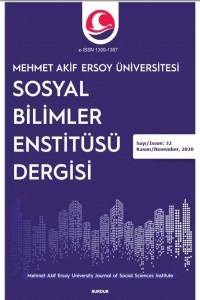TÜRKİYE’DEKİ UZUN HAVALARIN YAPISAL VE KARAKTERİSTİK ÖZELLİKLERİNİN BİLİNİRLİĞİNE YÖNELİK BİR DEĞERLENDİRME
Abstract
Ülkemizde geniş bir coğrafyaya çok farklı yapısal ve karakteristik özellikleriyle yayılan uzun havaların, bu geleneğin devamını sağlayacak eğitmenler tarafından bilinirlik seviyesinin ne düzeyde olduğunun araştırılması bu araştırmanın temel felsefesini oluşturmuştur. Araştırmanın çalışma grubunu, en az dört yıllık lisans eğitimi veren konservatuvarların, eğitim fakülteleri ve güzel sanatlar fakültelerin müzik bölümlerinden mezun olmuş, hali hazırda Türkiye’nin çeşitli bölgelerinde Türk Halk Müziği alanında eğitmenlik yapan 20 alan uzmanı oluşturmaktadır. Araştırmada, uzun hava kültürünün bilinirlik düzeyine yönelik katılımcıların görüşlerini almak için “Yarı Yapılandırılmış Görüşme” tekniği uygulanmıştır. Görüşmede katılımcılardan, uzun hava kültürü hakkındaki düşünceleri alınmış ve uzun hava kültürünün aktarımı konusundaki düşüncelerinin neler olduğu hazırlanan görüşme soruları aracılığıyla elde edilmiştir. Görüşmeler sonucunda elde edilen ham veriler içerik analizi tekniği kullanılarak analiz edilmiş ve araştırma sonucunda, uzun hava türleri hakkında kesin olmayan, farklılık gösteren ya da hiç bilinmeyen bilgilerin olduğu tespit edilmiş ve bu tespitler ışığında uzun havaların, öğretim ve intikal sürecine dair çeşitli önerilerde bulunulmuştur.
References
- Altınay, F. R. (2004). Cumhuriyet döneminde Türk halk müziği, İzmir: Balçova Kaymakamlığı Yayınları. Ay, G. (1990). Folklora giriş. İstanbul: Pan Yayıncılık. Balcı, A. (2001). Sosyal bilimlerde araştırma yöntem, teknik ve ilkeler. Ankara: Pegem Yayıncılık.
- Ekici, M. (2004). Halk bilgisi (folklor) derleme ve inceleme yöntemleri, Ankara: Geleneksel Yayıncılık.
- Güven, M. (2012). On bin yılın türküsü, Erzurum: Fenomen Yayıncılık.
- Meydan Larousse Ansiklopedisi. (1993). Kültür (Cilt 3), İstanbul: Sabah Gazetesi Yayınları.
- Nacakcı, Z. (2007). Halk ezgilerine dayalı viyola albümü, Ankara: Feryat Matbaacılık.
- Sönmez, V. ve Alacapınar, F.G., (2011). Örneklendirilmiş bilimsel araştırma yöntemleri, Ankara: Anı Yayıncılık.
- Tan, M. (1981), Toplum bilime giriş, Ankara: Ankara Üniversitesi Eğitim Fakültesi Yayınları.
- Thoms, W. J. (1965). "Folklore". The Study of Folklore. Edt. by Alan Dundes. New Jersey: Prentice-Hall. Uygur, N. (2018). Kültür kuramı. İstanbul: Yapı Kredi Yayınları.
- Yıldırım, A. ve Şimşek, H., (2006). Sosyal bilimlerde nitel araştırma yöntemleri, Ankara: Seçkin Yayıncılık.
Abstract
The basic philosophy of this research is to investigate the level of awareness of the uzun havas, which is spreading with a wide variety of structural and characteristic features to a wide geography in our country, by the instructors who will maintain this tradition. The study group is made up of 20 field experts, with at least four years of undergraduate education that conservatories, educational faculties and fine arts and graduated from the music department of the faculty, already serves as a teacher in Turkish folk music field in various regions of Turkey. In this study, semi-structured interview technique was applied to get the opinions of the participants about the level of awareness of uzun hava culture. During the interview the participants’ views about uzun hava were gathered and what their thoughts were about the transfer of uzun hava were obtained through the interview questions that were prepared. The raw data obtained as a result of the interviews have been analyzed by using the content analysis technique and it has been determined that there are no definite, different or unknown information about the uzun hava types and are made various suggestions about the teaching and the transfer process of uzun havas in the light of these findings.
References
- Altınay, F. R. (2004). Cumhuriyet döneminde Türk halk müziği, İzmir: Balçova Kaymakamlığı Yayınları. Ay, G. (1990). Folklora giriş. İstanbul: Pan Yayıncılık. Balcı, A. (2001). Sosyal bilimlerde araştırma yöntem, teknik ve ilkeler. Ankara: Pegem Yayıncılık.
- Ekici, M. (2004). Halk bilgisi (folklor) derleme ve inceleme yöntemleri, Ankara: Geleneksel Yayıncılık.
- Güven, M. (2012). On bin yılın türküsü, Erzurum: Fenomen Yayıncılık.
- Meydan Larousse Ansiklopedisi. (1993). Kültür (Cilt 3), İstanbul: Sabah Gazetesi Yayınları.
- Nacakcı, Z. (2007). Halk ezgilerine dayalı viyola albümü, Ankara: Feryat Matbaacılık.
- Sönmez, V. ve Alacapınar, F.G., (2011). Örneklendirilmiş bilimsel araştırma yöntemleri, Ankara: Anı Yayıncılık.
- Tan, M. (1981), Toplum bilime giriş, Ankara: Ankara Üniversitesi Eğitim Fakültesi Yayınları.
- Thoms, W. J. (1965). "Folklore". The Study of Folklore. Edt. by Alan Dundes. New Jersey: Prentice-Hall. Uygur, N. (2018). Kültür kuramı. İstanbul: Yapı Kredi Yayınları.
- Yıldırım, A. ve Şimşek, H., (2006). Sosyal bilimlerde nitel araştırma yöntemleri, Ankara: Seçkin Yayıncılık.
Details
| Primary Language | Turkish |
|---|---|
| Journal Section | Research Articles |
| Authors | |
| Publication Date | November 27, 2020 |
| Submission Date | August 16, 2020 |
| Acceptance Date | September 22, 2020 |
| Published in Issue | Year 2020 Issue: 32 |

This work is licensed under a Creative Commons Attribution-NonCommercial 4.0 International License.


